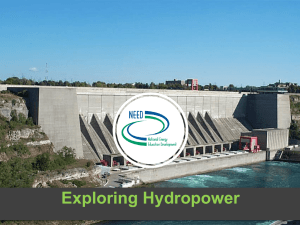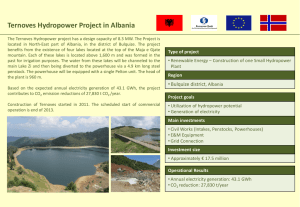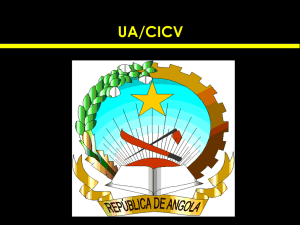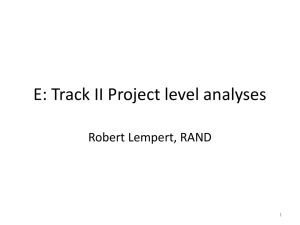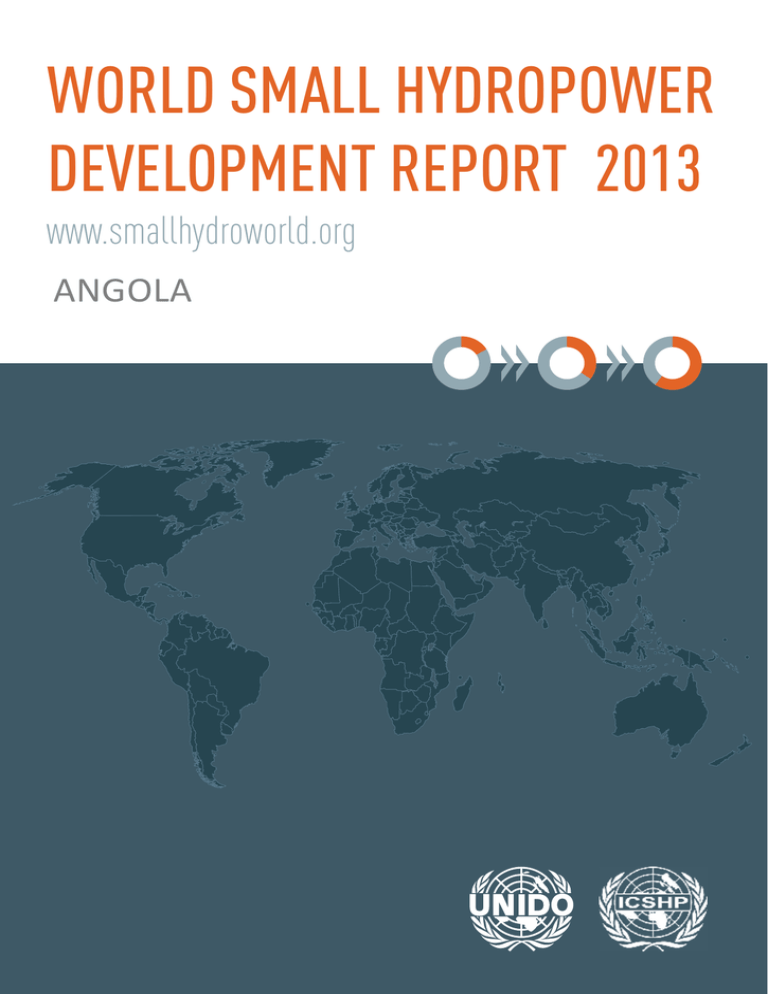
World Small Hydropower
Development Report 2013
www.smallhydroworld.org
ANGOLA
Disclaimer
Published in 2013 by United Nations Industrial Development Organization (UNIDO) and International Center
on Small Hydro Power (ICSHP).
2013 © UNIDO and ICSHP
All rights reserved
This report was jointly produced by United Nations Industrial Development Organization (UNIDO) and International Center on
Small Hydro Power (ICSHP) to provide information about small hydropower. The document has been produced without formal
United Nations editing. The designations employed and the presentations of the material in this document do not imply the
expression of any opinion whatsoever on the part of the Secretariat of UNIDO and ICSHP concerning the legal status of any
country, territory, city or area or of its authorities, or concerning the delimitation of its frontiers or boundaries, or its economic
system or degree of development. Designations such as “developed”, “industrialized” and “developing” are intended for
statistical convenience and do not necessarily express a judgement about the stage reached by a particular country or area in
the development process: Mention of firm names or commercial products does not constitute an endorsement by UNIDO or
its partners. The opinions, statistical data and estimates contained in the articles are the responsibility of the author(s) and
should not necessarily be considered as reflecting the views or bearing the endorsement of UNIDO and its partners.
While every care has been taken to ensure that the content is useful and accurate, UNIDO and ICSHP and any contributing
third parties shall have no legal liability or responsibility for the content or the accuracy of the information so provided, or for
any loss or damage caused arising directly or indirectly in connection with reliance on the use of such information.
Copyright: Material in this publication may be freely quoted or reprinted, but acknowledgement is requested, together with a
copy of the publication containing the quotation or reprint.
Recommended citation:
Liu, H., Masera, D. and Esser, L., eds. (2013). World Small Hydropower Development Report 2013. United Nations Industrial
Development Organization; International Center on Small Hydro Power. Available from www.smallhydroworld.org.
1 Africa
1.2 Middle Africa
sector, the investment opportunities and the efforts
put forward by the Angolan Government to attract
5
private sector involvement in the energy sector.
1.2.1 Angola
Small hydropower sector overview and potential
Angola has enormous hydropower potential.
Hydropower currently provides three quarters of the
country’s electricity (figure 1). However, the civil war
destroyed facilities and the Government has not
succeeded in keeping supply in line with expanding
demand. The technical hydropower potential is
around 80 TWh/year and the economically available
hydropower potential is 72 TWh/year (18 GW). Less
than 900 MW (out of 18 GW overall potential) have
6
been developed so far.
Lara Esser, International Center on Small Hydro Power
Key facts
Population
Area
Climate
Topography
Rain
Pattern
1
18,056,072
1,246,700 km²
Semi-arid in south and along coast to
Luanda; the north has a cool, dry season
(May to October) and a hot, rainy season
(November to April).
Temperature varies from 10°C to 31°C
Forty-seven hydrographical basins, well
irrigated by rivers coming from the
central plateau
Hot summer months are very dry, with
almost no rainfall (June to August). Wet
season (October to April) with 100-250
mm per month. The wettest region is the
north-east, and the total rainfall
decreases southwards and towards the
2
western coast.
The colonial policy was highly oriented towards
medium- and large-hydropower schemes with the
objective to provide big cities and centres with
electricity. Pico-, micro-, mini- and small- hydropower
schemes for supplying indigenous people with
electricity were given less priority.
In 1975, when Angola became independent, there
were three separated electricity grid systems. Only 12
per cent of the Angolan population had access to
electricity, of which 90 per cent were in Luanda, the
capital. According to the 2011 World Atlas and
Industry Guide, Angola has started reconstructing
Cavango small hydropower plant (10 MW) in the
centre of the country, which was damaged during the
civil war. In July 2011, the Angolan Ministry of Energy
and Water announced that it intended to build 150
micro-hydroelectric projects. It said that so far the
administrative procedures had already been
concluded, but neither specific localities to build the
projects nor the time to start operating were given. A
public tender to select a construction company, would
open soon. This action is part of the strategic plan of
the sector aimed to improve and expand the power
7
network countrywide.
Electricity overview
The national electrification rate was 26.2 per cent,
with 13.7 million people not having access to
4
electricity in 2011. The Angolan Government has a
National Electrification Programme, which has set a
target of increasing production to 7,000 MW, enabling
an annual per capita consumption of 4,000 kWh by
2016 – an eightfold increase in current consumption.
The medium-term goal is to develop capacity of 4,646
MW by 2017. There are also bottlenecks in the
transmission and distribution networks that need to
5
be overcome.
79.8%
Hydropower
Oil
20.2%
0%
20%
40%
60%
80%
SHP installed capacity
100%
Figure 1 Electricity generation in Angola
3
Source: Trading economics
Note: Data from 2010.
10 MW
SHP potential
134 MW
0
50
100
150
Figure 2 Small hydropower capacities in Angola
7
8
Source: Hydro World , Unknown
The Angolan Strategic Programme for Rural
Electrification is part of the National Programme and
also includes mini-hydro. Priority actions include the
building of new power plants (hydropower plants and
the reinforcement and expansion of the transmission
network to new municipalities and the construction of
transmission lines associated to the new power
5
lines).
Installed small hydropower capacity was 10 MW in
2008 (figure 2). The small hydropower development
programme (launched in 2008) by the Ministry of
Energy and Water aims to support preliminary studies,
technical
and
economic
feasibility
studies,
environmental studies, engineering project design and
construction of pico-, micro-, mini- and smallhydropower schemes with capacity up to 10 MW,
including transportation, distribution, public lighting
There is a focus on the existing hydropower potential
in Angola and its strategic role in the regional energy
1
and optional infrastructures. More than 112 projects
have already been identified (table). Projects are
listed and grouped into short-, medium- and longterm projects.
Potential micro hydropower sites up to 10 MW in Angola
Province
River
Waterfall/Locality
Bengo
Bengo
Benguela
Benguela
Benguela
Benguela
Benguela
Benguela
Benguela
Benguela
Benguela
Benguela
Benguela
Bié
Bíe
Bíe
Bíe
Bíe
Bíe
Bíe
Bíe
Bíe
Bíe
Bíe
Bíe
Bíe
Bíe
Loge
Lifune
Catumbela
Catumbela
Cuiva
..
..
..
F.S. André
F.Caála
F.Fasil
Mamducha
Açucareira
Gango Muanga
Gango
Gango
Gango
Cutatu
Luvulo
Cutatu
Cune
Kuquema
Cuito
Cuemba
Cunje
Cuanza
Cuanza
Bíe
Cuceque, Nedegiva
Bié
Bié
Bié
Bié
Bié
Bié
Cabinda
Cabinda
Cabinda
Cunene
Huambo
Huambo
Huambo
Huambo
Huambo
Huambo
Huambo
Huambo
Huambo
Huambo
Huambo
Huíla
Huíla
Huíla
Huíla
Huíla
Huíla
Huíla
Huíla
K.Kubango
K.Kubango
K.Kubango
Membia
Cunje
Cuemba
Kuito
Kuito
Cuhinga
Luali
Luali
Ngoti e LufoNgoti
Calueque
Culele
Calai
Cuando
Cuando
Cuando
Cuando
Cuando
Cuando
Capati
Cului
Cuando
Cuhui
Cuvango
Caculuva
Chicungo
Cavunge
Simo
Kubango
Cuvundi
LombaLomba
Cutato
Cuito Moleo
Cuito
Cubango
Freitas Morna/ Ambriz
Nambuangong/ Nambuangongo
Chicuma/ Chicuma
Catumbela/ Cuvera
Cuiva / Ganda
F.Sisalana/ Ganda
F. A Cubal/ Cubal
F. Portelas/ Caimbambo
../ Chongoroi
../ Balombo
../Bocoio
../ Bocoio
../ Catumbela
Tunbo/Tassongue/Quipelo/Lunga/Embal Andulo/Andulo
Samalanca/Cutatu/ Andulo
Chivava/Cundende/ Kamakupa
Chimbenda/Cuemba/Quissol/Cativa/Cuanza/ Dando, Cama Cupa,
Catabola, Chipeta,
-/ Nedegiva, Cassombi,
Muamdoge,
Membia/ Andulo
Cunje/ Catabola
Cuemba/ Cuemba
Kuito1/ Cidade Kuito
Kuito2 / Cidade de Kuito
Cuhinga/ N'Harêa
Luali/ Buco Zau
Luali/ Buco Zau
-/ Belize
Caluueque/ Calueque
Culele/ Babaera
Chissola/ Cuima, Chissola
Lucunde/ Cataala-Nova
Lava Cuando/ Lava do Cuando
Cuando/ Huambo
Caringo/ Caringo
Gungue/ Gungue
Lucunde/ Lucunde
Cabundi/ Cabundi
Catembulo/ Catembo
Carngo/ -/ Jamba
-/ Cuvango
-/ Chibia
-/ Chicungo
-/ Chicoma
-/ N’Gola
Kuvango/ Mongonga Kuvango
Cuvundii/ Chicomba
-/ Mavinga
Cutato/ Cutato
M´pupa/ Dirico,
Licua
Maculungungo/ Caiundo
K.Kubango
Source: Unknown8
Note: This is an incomplete list.
2
Expected power
(kW)
6 000 - 7 000
400
8
..
..
..
..
..
..
..
..
..
..
9 300
1 100 - 3 000
6 000- 1 500
5 500- 10 000
6 900 - 15 000
2 500 - 5 000
4 100 - 10 000
7 200 - 15 000
700 - 1 000
300 - 1 000
6200 - 15 000
1 800 - 15 000
8 400 - 15 000
..
..
80 - 500
2640
275 - 500
100
100 - 600
2 400
1 500 - 750
2 500 - 750
20 - 50
4 300 - 6 500
6 500 - 6 500
1 200 - 3 200
3 400 - 5 000
4 000 - 5 300
6 500
3 600 - 14.5
5 000
3 400 - 5 000
400 (500 KVA)
160 (200 KVA)
16 (20 KVA)
2 866 (kVA)
624 (kVA)
2 500 - 5 000
Prioritization of projects was carried out according to
social, economic and political objectives. The main
goal is to create the National Data Bank on the
8
Angolan small hydropower potential in 2008-2013.
www.cia.gov/library/publications/the-worldfactbook/
2. McSweeney, C., New, M. and Lizcano, G. (n.d.)
UNDP Climate Change Country Profiles:
Angola. Available from
www.geog.ox.ac.uk/research/climate/projects/undpcp/UNDP_reports/Angola/Angola.lowres.report.pdf
3. Trading Economics. World Bank Indicators - Angola Energy Production and Use. Available from
www.tradingeconomics.com/angola/electricityproduction-from-oil-sources-percent-of-total-wbdata.html
4. International Energy Agency (2011). World Energy
Outlook 2011. Paris, France. Available from
www.worldenergyoutlook.org/
5. Angola, Ministry of Energy and Water (2011).
Challenges of the Angola Power System for the Period
of 2009-2016.
6. Aderito Figuera, Ministry of Energy and Water,
Sigma Group (February 2011). Energy Market in
Angola. Email to author. 14 March 2012.
7. Hydro World (2011). Angola: 150 small hydropower
projects planned, 7 July. Available from
www.hydroworld.com/articles/2011/07/angola--150small.html
8. Unknown (2008). Development of Small Hydro
Power in Angola. Paper presented at the Seminar on
Small Hydro Power and Sustainable Development of
Rural Communities, 21 April- 5 May. Hangzhou.
9. Ventura, J. (2012). Ministry creates legislation on
renewable energy, Angola Press, 5 September.
Available from
www.portalangop.co.ao/motix/en_us/noticias/socied
ade/2012/4/19/Ministry-creates-legislationrenewable-energy,4ea45b12-2bbb-47fc-beeda94054b576c3.html. Accessed December 2012.
The programme will implement up to 50 projects to
the preliminary and feasibility study stage and
construct 30 hydropower schemes. Up to 20 pico- and
micro-units are expected to be imported during this
period and will be sold to small rural consumers.
Furthermore, the programme wants to develop
conditions for the launching of siderurgical (iron- and
steel-works), metal-mechanic and electric industries
for the local manufacturing of some components. In
terms of population welfare, more than 4.4 million
people in local and rural areas from 15 provinces will
benefit from the programme and more than 7,000
permanent and temporary jobs will be created. The
total cost of the programme (2008-2013) is estimated
at more than US$900 million. The Government will be
responsible for 60 per cent and private investment
8
should cover the rest (40 per cent).
Renewable energy policy
The Angolan Ministry of Energy and Water Affairs is
responsible for the National Energy Policy, including
the promotion of renewable energy sources. In
September 2012, the Ministry indicated that it was in
the process of creating legislation to regulate the
renewable energy sector. The idea behind it was to
deploy renewable sources to enable the expansion of
electricity to homes in need and to ensure that
9
citizens pay a fair price for energy.
Reference
1. Central Intelligence Agency (2012). The World
Factbook. Available from
3
United Nations
Industrial Development Organization (UNIDO)
Wagramer Straße 2, 1220 Vienna
Austria
International Center
on Small Hydro Power (ICSHP)
136 Nanshan Road, 310002 Hangzhou, Zhejiang
Province, China
renewables@unido.org
report@icshp.org
www.smallhydroworld.org

